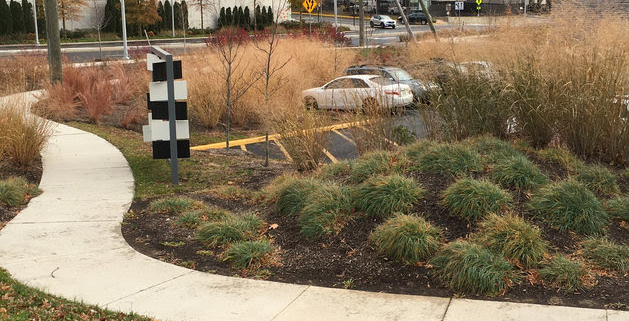Native plants in public spaces
Article by Plant NOVA Natives
Shopping center parking lots and other public spaces can be tree-lined havens from the summer heat, with beautiful blossoms to induce people to linger. Imagine yourself resting on a shaded bench, listening to the birds as you enjoy watching the people stroll by. Do the commercial spaces in your town look like this, or do you find yourself hurrying from car to building to get out of the glaring heat? Wouldn’t you prefer to do your shopping at the place with more greenery?
Commercial establishments across the region are starting to appreciate the return on investment of native plants. There are practical reasons related to the fact that they are adapted to the Virginia climate. Native Virginia plants require less watering (once established) than rows of annuals and only need to be planted once. Native shrubs such as Virginia Sweetspire require no pruning and provide more natural-looking alternatives to conventional landscaping choices that get leggy with continuous trimming. No fertilizers and pesticides are needed, either. Beyond the practicalities, though, companies that choose native plants are signaling to the public that they are good corporate citizens who care about our common home and are working to preserve our heritage.
In many cases, property managers are taking the simple step of swapping out the non-native in their curbside beds for reliable natives such as Threadleaf Coreopsis, Common Yucca, Black-Eyed Susan and Common Yarrow. Winterberry Holly, with its bright red berries, has become a popular choice to place next to buildings. Some landscapers are installing innovative designs that give the property a whole new look, incorporating a wide variety of shrubs and ornamental trees such as Redbud and great swaths of native grasses such as Switchgrass waving in the breeze. An example of that can be seen at Caboose Commons in Fairfax, where imaginative landscaping adds a new dimension to the dining experience. Still other establishments such as Vienna Vintner have planted extensive pollinator gardens leading up to their entrances, with flowers that bloom in succession and attract butterflies from early spring to late fall.
You may have noticed sidewalks and parking lots that have sunken islands. Stormwater retention areas, which are mandatory for new development, provide an opportunity for creative landscaping. Water and drought tolerant trees such as Red Maple and Serviceberry can provide shade while their roots absorb the runoff. Native grasses, perennials and shrubs help clean the water while adding color and interest to the design.
Photos and details about landscaping with native plants in commercial spaces can be found on the Plant NOVA Natives website. The Caboose Commons project is highlighted in the first Plant NOVA Natives video for landscape professionals. Produced by volunteer Joe Bruncsak, owner of Blue Land Media, this series of very short videos will feature projects that exemplify landscape design at its best.




